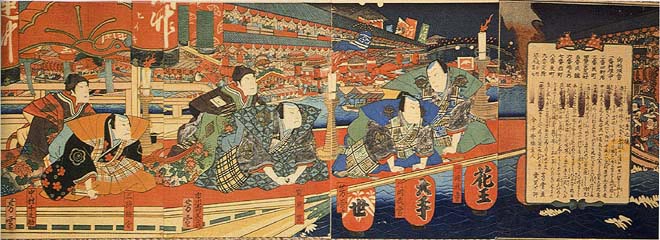Home •
Recent Update •
Sales Gallery •
Archives
Articles • Varia • Glossary • Biographies • Bibliography Search • Video • Contact Us • Conditions of Sale • Links |
|
Just like a Hollywood movie, an ukiyo woodblock print is the product of a sophisticated joint effort. In the case of the earlier popular art form, distinct roles were played by a designer, a publisher, the carving team and the printers. This is well-known to most ukiyo-e collectors, as is the fact that these roles have been listed here in order of descending fame but not necessarily importance. Also worth remembering, however, again just like Hollywood, is that Edo and Osaka print publishers adapted to a variety of social and commercial restraints in deciding the look and feel of their works. For example, producing a series of prints, or even a deluxe single sheet, was too risky a venture without some kind of subsidy or guaranteed sales, particularly so in Osaka with its infinitely smaller market Thus one can discover in ukiyo-e numerous examples of advertising and promotion. To be sure, some examples are more subtle than others. If you see the name of a business in a print, perhaps a shop sign or something written on an umbrella or a box, it would not be too commercially-minded of you to assume that money changed hands in order for it to be there. Less obvious at first: What better promotion could the kimono industry hope for than to have their latest designs being paraded on the shoulders of a beautiful geisha? In fact, the links between the kimono and publishing worlds are as well documented as those between Armani and Warner Brothers.
|
As for kabuki prints, the influence on ukiyo-e history of individual actors' fan clubs can not be overrated. These clubs, like the ones shown here in the theater district along the Dôtonbori, welcoming their heroes back to Osaka for a new season, had both the fervor and the financial means to either subsidize deluxe editions or else commission entirely new designs, something they did with regularity in Osaka. And since the publishers were essentially reduced to vanity press status in such cases, the clubs could dictate the choice of artist or even submit their own design These fan club-inspired prints — not to be confused with fan prints! — comprise some of the most exquisite, lavishly produced ukiyo-e in existence. The print above, by Osaka artist Yoshiyuki (1835-75; active 1856-72), is interesting in that it came with a wrapper (first sheet on the right) which continues the boat design as it lists the neighborhood clubs. Knowing how Japanese love to wrap things, one wonders how many other prints originally sported protective envelopes. This article originally appeared in Daruma, no. 10, Spring 1996. Copyrighted © text and pictures reprinted with permission.
|
|
||||||

